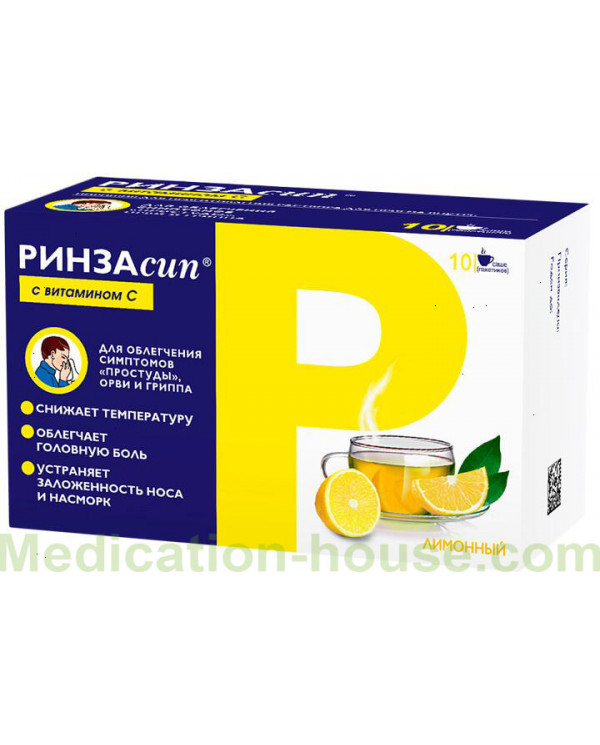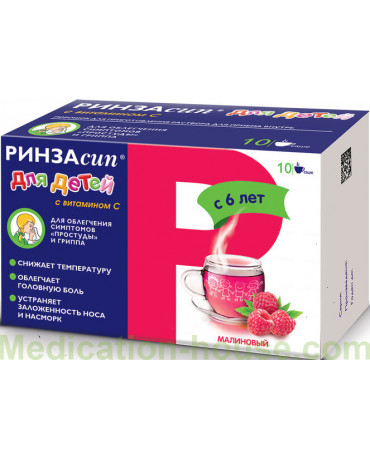Rinzasip instruction
You can buy Rinzasip on this page
Release form and composition
Rinzasip is available in powder form for the preparation of a solution for oral administration:
Orange powder: from light orange to orange, with a splash of white and orange and orange flavor (5 g each in a sachet, in a cardboard box of 5, 10, 25, 50 or 100 sachets);
Lemon powder: from light yellow to yellow, with a splash of white and yellow and a lemon flavor (5 g each in a sachet, in a cardboard box of 5, 10, 25, 50 or 100 sachets);
Blackcurrant powder: from pink to pinkish-red in color, interspersed with white and red in color and blackcurrant flavor (5 g each in a sachet, in a cardboard box of 5, 10, 25, 50 or 100 sachets).
Composition 5 g (1 sachet) of powder:
Active ingredients: caffeine - 30 mg, phenylephrine hydrochloride - 10 mg, paracetamol - 750 mg, pheniramine maleate - 20 mg;
Auxiliary components: sodium citrate, anhydrous citric acid, sucrose, sodium saccharin, colorants and flavors (for orange-flavored powder: orange flavorant, Sunset yellow colorant FCF; for lemon-flavored powder: lemon flavorant, quinoline yellow colorant; for powder with blackcurrant flavor: blackcurrant, raspberry and fruity flavoring substance, karmoizin dye).
Pharmacodynamics
Paracetamol is part of the anilide group and is an analgesic and antipyretic. It has an antipyretic and analgesic (eliminates headache, joint and muscle pain, as well as sore throat) action, and is also characterized by a small anti-inflammatory activity. The substance has practically no toxic properties compared with other drugs in this group.
Paracetamol is an inhibitor of prostaglandin synthesis. This process is carried out by blocking both forms of the cyclooxygenase enzyme. Also, the compound selectively blocks COX3 (central nervous system) without affecting COX1 and COX2 localized on the periphery.
Paracetamol does not negatively affect the functioning of the digestive tract and does not lead to disturbances in the water-electrolyte balance and the retention of sodium ions in the body.
Pheniramine is a potent antihistamine and a blocker of H1-histamine receptors. It reduces the degree of capillary permeability, eliminates bronchial spasm and is characterized by decongestant activity, eliminates itching of the throat, nose and eyes, hyperemia and swelling of the sinuses and mucous membranes of the nose and nasopharynx. The substance also exhibits weak sedative properties, reduces exudative manifestations and is able to reduce the intensity of mucus production in the bronchi and nasopharynx.
Caffeine stimulates the central nervous system and improves both mental and physical performance. In combination with paracetamol, it increases effectiveness and accelerates the absorption of the latter in the body.
Phenylephrine is an alpha-adrenergic agonist, which helps to narrow blood vessels, reduce pressure in the sinuses and middle ear, eliminate swelling of the mucous membranes, and also increases blood pressure. If the substance is used often and over a long period of time, it is possible to develop an organism's tolerance to it, which will require an increase in dosage.
Pharmacokinetics
Paracetamol crosses the blood-brain and placental barriers and is absorbed in the small intestine. The degree of binding to blood plasma proteins is quite high. The maximum concentration of a substance in the body is determined 30-60 minutes after administration. The pharmacokinetics of the remaining active components of Rinzasip are not well understood.
Indications for use
According to the instructions, Rinzasip is used for the symptomatic treatment of acute respiratory viral infections, flu and other colds (to reduce febrile syndrome, pain and rhinorrhea).
Contraindications
Absolute:
Children's and teenage age up to 15 years;
Period of pregnancy;
Lactation period;
The simultaneous use of other drugs, which include the active ingredients of Rinzasip powder;
The simultaneous use of beta-blockers, tricyclic antidepressants and monoamine oxidase inhibitors;
Hypersensitivity to the main or auxiliary components of the drug.
Relative (Rinzasip powder is used with caution):
Arterial hypertension;
Bronchial asthma;
Severe atherosclerosis of the coronary arteries;
Diabetes;
Pheochromocytoma;
COPD (chronic obstructive pulmonary disease);
Hereditary hyperbilirubinemia (Dubin-Johnson, Rotor and Gilbert syndrome);
Thyrotoxicosis;
Blood diseases (anemia, thrombocytopenia, hemorrhagic diathesis, etc.);
The angle-closure form of glaucoma;
Deficiency of glucose-6-phosphate dehydrogenase enzyme;
Renal and / or liver failure;
Hyperplasia of the prostate gland.
Instructions for use: method and dosage
The drug Rinzasip is taken orally with a large amount of water or other liquid 1-2 hours after a meal. To prepare the solution, the contents of one sachet are poured with one glass of hot water and thoroughly mixed until the powder is completely dissolved. If desired, honey or sugar can be added.
Adult patients and adolescents over 15 years of age are prescribed 1 sachet of the drug 3-4 times a day. It is necessary to observe the interval between doses of Rinzasip powder. It should be at least 4-6 hours. The maximum dose is 4 sachets per day. The duration of therapy is no more than 5 days.
Side effects
Digestive system: epigastric pain, dry mouth, nausea, hepatotoxic effect, constipation;
Cardiovascular system: tachycardia, increased blood pressure;
Central nervous system: increased irritability, dizziness, paresis of accommodation, impaired falling asleep, increased IOP (intraocular pressure), mydriasis;
Urinary system: toxic kidney damage, urinary retention;
Hematopoietic system: agranulocytosis, aplastic anemia, pancytopenia, anemia, methemoglobinemia, thrombocytopenia, hemolytic anemia;
Allergic reactions: urticaria, pruritus, angioedema, skin rash;
Other reactions: biofeedback (bronchial obstructive syndrome).
Overdose
An overdose of Rinzasip is usually caused by paracetamol, and its symptoms appear after taking 10-15 g of the latter. It is usually expressed by symptoms such as nausea, vomiting, anorexia, increased activity of hepatic transaminases, hepatonecrosis, an increase in prothrombin time, and pallor of the skin. If they occur, you must immediately consult a doctor.
As a treatment, gastric lavage is recommended, followed by activated charcoal, symptomatic therapy and the administration of methionine 8–9 hours after an overdose and acetylcysteine 12 hours later.
special instructions
During the use of Rinzasip, it is necessary to refrain from taking anxiolytic or sleeping pills and drinking alcohol.
Co-administration with other drugs, which include paracetamol, is prohibited.
If after 3-5 days of using Rinzasip powder, the patient's condition does not improve, you should consult a doctor.
During treatment, special care should be taken to perform work requiring a high concentration of attention and a quick reaction.
Drug interaction
Rinzasip enhances the effects of ethanol, sedatives, and monoamine oxidase inhibitors.
With simultaneous use with antiparkinsonian drugs, antidepressants, phenothiazine derivatives and antipsychotic drugs, the risk of dry mouth, urinary retention and constipation increases; with glucocorticosteroids - the likelihood of developing glaucoma increases; with diuretics - their effectiveness decreases; with barbiturates, rifampicin, carbamazepine, diphenin - the risk of hepatotoxic effects of paracetamol increases.
Rinzasip reduces the antihypertensive effect of guanethidine, and the latter enhances the alpha-adrenostimulating effect of phenylephrine.
When combined with halothane, the likelihood of developing ventricular arrhythmias increases, with tricyclic antidepressants, the adrenomimetic effect of phenylephrine is enhanced.
Terms and conditions of storage
Store in a dry place at a temperature not exceeding 25 ° C. Keep out of the reach of children. Shelf life is 3 years.
Reviews
Numerous reviews about Rinzasip are mostly positive. The drug has proven effective and is relatively inexpensive. Patients note a low incidence of adverse reactions and a rapid improvement in well-being. However, do not forget that Rinzasip only eliminates the negative symptoms of the disease, without affecting its causes. Before starting treatment, it is recommended to consult a specialist.
Terms of sell
You don't need a prescription to buy Rinzasip.


